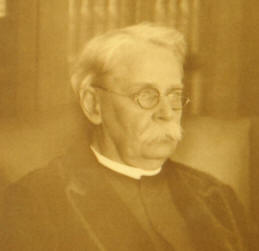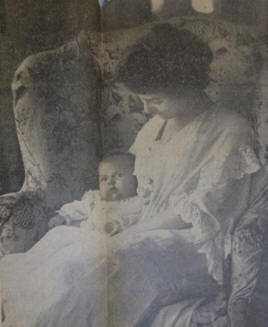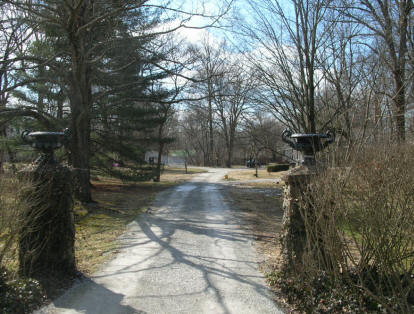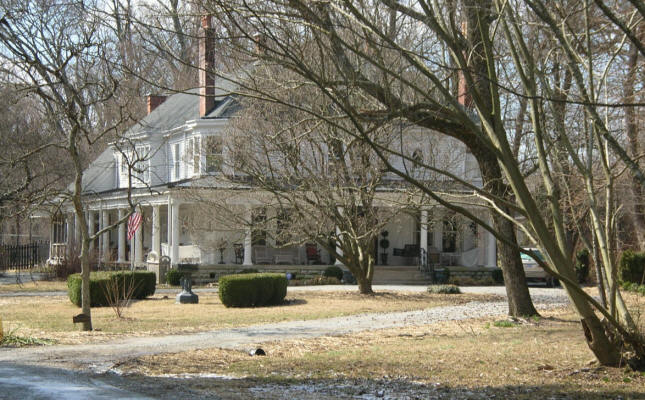“Bernersyde” or “Bemersyde”
Home of Rev. Dr. Peyton Harrison Hoge
The “home of Peyton Hoge” was never in any of the Little Colonel stories. However, the Hoge family who lived there certainly knew Annie Fellows Johnston and many of the other people in Pewee Valley who served as models for characters in her books.
According to “Historic Pewee Valley,” page 39:
“Bernersyde, located at 114 Central Avenue, is a large, twenty-two room eclectic house significant for its Colonial Revival influence and its sheer size. This two-story weather boarded house was totally remodeled in 1907 from a much smaller house built between 1880 and 1900.”

Rev. Peyton Hoge
The year that Bernersyde/Bemersyde was remodeled was the year that the Rev. Peyton Harrison Hoge became the minister at Pewee Valley Presbyterian Church. He served as Pastor and Pastor Emeritus there from 1907 until 1929. How he came to be pastor of the little church, after serving as the pastor of the much-larger and more prestigious Warren Memorial Presbyterian Church in Louisville, is explained by his daughter, Cary Hoge Mead, who privately published her memoirs, “Sunshine and Shadow,” in 1983:
“Sunshine and Shadow,” pgs. 50-51…”Mama had seemed worried and unhappy about something, and she skipped parts of papa’s letters when reading them to me, but it wasn’t until almost time for us to leave (Italy where Cary and her mother were visiting) that she told me we would not be going back to Louisville, but to a suburb named Pewee Valley, where Papa would be pastor of a little Presbyterian church, having resigned from Warren Memorial.
It wasn’t until years later that I learned the whole sad story about that. As I mentioned earlier, there were many wonderful, truly Christian members of Warren Memorial Church, but there were also some of the most quarrelsome people who ever considered themselves Christian. Before leaving the Wilmington Church (in North Carolina, which he pastored from 1894 to 1899), Papa had performed the marriage ceremony of one of the church girls to a man who was divorced. The divorce had been one of the few which could be justified, for Mr. F. had endured years of nominal marriage with a truly venomous, vicious woman. There had been no secret about Papa’s performing that ceremony ten years before, but the trouble-makers decided to make an issue of it at this point and harassed Papa to the point of resignation. He was then called to the Presbyterian church in Princeton, but the trouble-makers, some of whom were on the ‘session’ at Warren Memorial, went to the Presbytery, and from there to the Synod, making a big ploy about Papa condoning the immorality of divorce, and the Synod insisted that the call be withdrawn.”
The “Mr. F” Cary Hoge Mead referred to was Henry Flagler (1830-1913), tycoon, real estate promoter, railroad developer and a partner with Rockefeller in Standard Oil. The woman he married was the much younger Mary Lily Keenan. Dr. Hoge financed Bernersyde’s/Bemersyde’s renovations through a gift received from Henry Flagler:
“Sunshine and Shadow,” page. 51: “…Papa bought a sweet old rambling house with three acres of land across the road from the little church in Pewee Valley. Not being really aware of all the heartache which this move involved, I was thrilled at living in the country. Mr. F., who was not only a man of wealth and prominence, but a great-hearted gentleman as well, hearing of Papa’s move, delved into the reasons. He discovered the dastardly behavior of the church, Presbytery and Synod, and feeling that his happy marriage had innocently wrecked Papa’s career, insisted on giving him at this time what he had planned to leave in his will. Careful investment of this wonderfully generous gift, plus the small salary from the little church, gave us enough to live on.”
According to Mead, the house was named Bemersyde (not Bernersyde as recorded in “Historic Pewee Valley”), because “there was a little brook running through it.” (Note that Bemersyde was the name of an historic house located in St. Boswell’s, Berwickshire in the Scottish Borders. During his lifetime, the novelist and poet Sir Walter Scott was a frequent visitor there.)
Mead’s memoirs also include remembrances of Annie Fellows Johnston, her daughter Mary G. Johnston, Fannie Craig, Hattie Cochran and other Little Colonel folks. Here are excerpts:
“Sunshine and Shadow,” pgs. 51-53, her experiences at the Villa Ridge School:
“Miss Fannie Craig, and her mother and brothers, lived next door to us. She played the organ at church, and she also ran a little school in a small building on their place, with the help of one assistant. There was a big room where we had our desks in one end, and Miss Fanny taught in the other end and a smaller room where her assistant, sometimes Miss Annie and sometimes Miss French Blackley, taught. Then there was a little room for our coats and rubbers, and that was it. There was a big stove in the big room and a smaller stove in Miss Blackley’s room, but no plumbing or electricity. There was plenty of light from the windows, and nothing went on there at night, so lights were not needed. (As a matter of fact, our houses in Pewee Valley were all lighted with lamps until several years later.)
“There were perhaps 25 pupils in this school, ranging in age from first grade through high school. Naturally the curriculum was limited, with so few pupils and only two teachers, so grades were somewhat mixed up. But Miss Fannie managed wonderfully, and she taught us far more than could be found in books.
“She also gave me piano lessons, and I think back to her patience and kindness with deep gratitude all these many, many years. I didn’t read music well, because I kept looking at my hands and so lost the place. Miss Fanny said that my hands were like bad children who didn’t do what they should unless being watched. I tried hard to keep my eyes on the music, and she tried many tricks to keep me from looking at those unruly hands, but I never did learn to sight read. Mama taught me French, and later Papa taught me Latin. When, after struggling through grammar and Caesar’s Gallic wars, we started Virgil, he made me and the others who joined the class feel the majesty and beauty of the lines, and each day he prepared a translation of our lesson in iambic hexameter verse to read to us after we had fumbled and stumbled through the lesson.”
“Sunshine and Shadow,” pgs. 56-57, description of her sister Mary’s wedding to George Harrison Houston at the Pewee Valley Presbyterian Church:
“..Papa had made a little path from the foot of the porch steps to a little gate opposite the gate to the walk of the church. he had planted young dogwood and redbud trees along this path, and they were all in bloom for the great day (April 29, 1909). I’ll never forget how lovely it was to see the procession — the girls in their pastel dresses with their bouquets of flowers and picture hats, and the men in their formal attire — winding down the path under blossoming trees. It was always called ‘the Bridal Path.’
The church people had created a sort of bower of white and lavender lilacs on a frame of chicken wire that made a sort of arch above the pulpit. I think every bush in that little town had contributed generously to make the setting for Mary’s wedding absolutely exquisite.
“After the tender and meaningful ceremony, Mary and George stood under a beech tree in the church yard, greeting all the friends who would have attended the reception, had there been a real one. (Note: a real reception was impossible, because the Hoge family was in mourning for the loss of Mrs. Hoge’s father). She was something to behold as she stood there, her veil and filmy wedding gown fluttering in the breezes, her eyes shining, and her cheeks flushed with happiness. This impromptu reception was beautifully recorded by Miss Kate Matthews, who was a gifted and artistic photographer.
“Sunshine and Shadow,” pg. 60, remembrances of the choir at the Presbyterian Church:
“…We soon started a little choir. Miss Fanny was, of course, at the organ and Mr. Ed Matthews played the violin. The only trouble was that sometimes Mr. Ed and Mr. Gatchel, who was the tenor, had to be deacons and take up the collection, so Miss Fanny would play something on the organ while they took up the collection, and then we would have the anthem. Papa would step down from the pulpit and sign bass.”
“Sunshine and Shadow,” pgs. 63-65, remembrances of Annie Fellows Johnston and Mary G. Johnston
“About this time two dear and wonderful people came into my life, Mrs. Annie Fellows Johnston and her stepdaughter, Miss Mamie Johnston. Many years before Annie Fellows had married Mr. Johnston, who was a widower with three children — Mamie, aged 15, Rena, aged 10, and John, aged five, who adored Mrs. Johnston and was as close as an own son. In fact, they all ere, for Mrs. Johnston had the key which unlocked all hearts, especially children and young people. The children’s mother had died when John was quite little, and they welcomed this God-given mother with their whole hearts. After only two years of happiness, Mr. Johnston was taken ill, and after three years of invalidism, during which the family’s financial resources were used up, he died. This left Mrs. Johnston with three rather delicate dependents and no money. However, Mamie was a gifted artist and helped out by selling some of her paintings while Mrs. Johnston was becoming established as an author.
“I had been given a copy of “The giant Scissors” and one or two other books of hers two or three years before we moved from Louisville, and as soon as we moved to Pewee Valley, I began hearing about, and reading, “The Little Colonel Books.” These were about all the people who lived there — the Lawtons, Miss Fanny, the Dulaneys, the Matthews with Hattie Cochran, the center of them all as “The Little Colonel.” As we youngsters waited eagerly for each new book to come out, we did not realize that Rena had died — of appendicitis, I believe — and that Mrs. Johnston and Mamie and John were living in Texas near San Antonio. Their place was called “Pen Acres” because Mrs. Johnston had earned the money to buy it with her pen. They had gone to Texas in the hope of saving John’s life (he had tuberculosis), but after years of struggle, the end came. After selling “Pen Acres,” Mrs. Johnston and Mamie returned to Pewee Valley, bought “The Beeches” and settled there amidst a host of devoted friends. These two ladies were the exemplification of all that is best in people. They suffered adversity and the loss of one after another of those they loved most dearly, but, like tempered steel, they just became finer. Sorrow had left its mark on both of their beautiful faces, but there was no atmosphere of sadness in their home, only cherished remembrance and outgoing friendliness and vitality.
“Miss Mamie had curly, golden hair which she wore parted in the middle and caught up in a bun on the back of her head. Mrs. Johnston was a brunette, lovely dark eyes which always shone, and soft brown hair. Both were slender, erect of carriage, and they were always immaculate. I used to wonder if ever, under any circumstances, I could achieve such personal daintiness and neatness. Shining through their loveliness was a beautiful spirit, a deep and abiding Christian faith.
“Papa prevailed on Mrs. Johnston to teach a class of girls on Sunday — not exactly Sunday School, as we were getting into our teens, but helping to make the Bible come alive for us, and hopefully prepare us to learn to teach Sunday School when we were a little older. Studying under her was an experience I wish every young person could have. She made everything so vivid and put in little touches of humor which made the lessons stick. She drew a delightful word picture of Joseph and his brothers falling on each other’s necks and weeping when Joseph was made known to them, their false beards getting all askew.
“Miss Mamie had a beautiful flower garden, as did Miss May Dulaney, and we girls used to think how wonderful it would be to be married in one of those gardens — we couldn’t decide which. Of course, that was silly, as we would not have dreamed of being married anywhere except in the beautiful little church.”
“Sunshine and Shadow,” pgs. 68-69, remembrances of her sister Bess’ coming out with Hattie Cochran and of the vegetable garden at Bemersyde”
“Bess had made her debut that year and was quite a ‘toast.’ She had much of Mamma’s wit and charm, and things were generally gay and full of laughter wherever she was. ..They (the debutantes) were a delightful group that year, and they all had a glorious time; Eliza Grinstead, whom William (Cary’s brother) described as having a flower-like face and stem-like figure — Julia Kinkead, who was a redhead and full of fun — Lala Swearingen, also a redhead — Nellie Ganter, a darling — Hattie Cochran (the Little Colonel) and her cousin, Blanche Weissinger Smith, with whom Peyton (Cary’s brother) fell completely and permanently in love — to name a few whom I knew and loved the most. (Blanche and Peyton celebrated their 64th wedding anniversary in April of 1977) (Note: their actual wedding date was April 17, 1913)
“When we moved to Pewee Valley, we were able to have a large vegetable garden, and this was one of Papa’s special interests, and he did much of the work in it — planting, weeding, and harvesting. When it was producing abundantly, we had very delightful “preserving-the-fruits-of-the-earth” sessions.
“We had a large screened porch off the kitchen with some long, low tables. Mama and whatever daughters were available would prepare the fruits or vegetables for preserving or canning and Papa would read to us. Thackeray, George Elliot, Scott, Kipling and Tennyson came in for their full share of attention and these reading sessions not only turned a chore into a pleasure, but added greatly to our literary knowledge and love of good literature. They were delightful mornings. Then, after lunch, if it was canning, Papa did the processing. The feminine members of the family did the preserving and jelly making….”

Kate Matthews photo of Blanche Weissinger Smith Hoge
(the Little Colonel’s real-life cousin) holding her son,
Peyton Hoge III, shortly after his birth.
He later became Mayor of Anchorage.
Photo probably taken at The Gables
From the Kate Matthews scrapbook at the
Louisville Free Public Library’s main branch on York Street.
“Sunshine and Shadow,” pgs. 71-73, remembrances of Alice Malone and a benefit for the Fresh Air Home:
“A friend of mine in Pewee, Alice Malone, became deeply interested in the Fresh Air Home,” a sort of summer camp where children from the city slums could come for two or three weeks of life in the country, with good food and out–f-door play, some care and love. We decided to give a “benefit.” We would give a piano recital at our house, Virginia (Cary’s sister Virginia Hoge San) would sing a couple of solos after we had each played three pieces, then we would each play two more, and wind up with Liszt’s Second Rhapsody as a duet. people would make an offering, and Mama would have refreshments. How we did practice! We would do our regular two or three hours a day for our lesson, and then have a joint session at our house and work on the program pieces which were to include Bach’s Two and Three-part Inventions, some Chopin, Beethoven, Godard, Mendelssohn, Debussy, etc. The whole community came and were so generous that we had nearly $60.00 to contribute. I think Mama’s luscious ice cream and cake were probably more enjoyable than our playing, but they would have come anyway to encourage us in such an earnest philanthropic effort.
“Sunshine and Shadow,” pgs. 76, Blanche and Peyton Hoge (II) at The Gables:
“During my junior year at K.H.S. (Kentucky Home School) Peyton Harrison Hoge III was born to Blanche and Peyton on their first anniversary…Blanche and Peyton also lived in Pewee Valley in a dear little house they rented from Mrs. Johnston…” (webmaster’s note: Peyton Hoge III would later become the Mayor of Anchorage.)

Entrance to Bernersyde
Additional pictures of Rev. Peyton Hoge and his daughter, Virginia Hoge San, are shown on the Post Office page.
Page by Donna Russell with many thanks to Peyton Hoge of Louisville (the Rev. Peyton Hoge’s great-great-grandson) for the photograph and to Nancy Azzam, a direct descendent of Rev. Hoge’s sister, Elizabeth Lacy Hoge Irvine, for the copy of “Sunshine and Shadow.”
